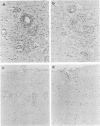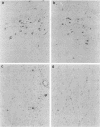Abstract
Theiler's murine encephalomyelitis virus infection of mice is an animal model for human demyelinating diseases. To further define the role of this virus in the disease process, we selected a virus variant resistant to neutralization by a monoclonal antibody to VP-1. This virus variant was then injected into SJL/J mice. Central nervous system tissue was compared between variant virus- and wild-type virus-infected mice. Within the brain, no large differences were observed between the two groups as to the distribution of inflammatory infiltrates around the injection site and the number of viral antigen-positive cells during the first weeks of the observation period. In contrast, in the spinal cord major differences were found between variant virus- and wild-type virus-infected mice regarding the number of inflammatory lesions, infected cells, and the size of the areas involved with time. By immunohistochemistry, equivalent numbers of infected cells could be found in the spinal cord 1 week postinfection (p.i.): however, after that time, the number of infected cells in the wild-type virus-infected mice continued to increase, whereas the virus-positive cells from the variant virus-infected mice gradually decreased. Thus, the number of viral antigen-containing cells peaked by 1 week p.i. in the variant virus-infected animals. Conversely, the number of infected cells in the spinal cords from mice inoculated with wild-type virus steadily increased until 8 weeks p.i. At this time (8 weeks p.i.), no more variant virus antigen-positive cells could be observed within the spinal cord. Plaque assay of central nervous system tissue confirmed these differences between the two groups observed by immunohistochemistry. No infectious variant virus could be isolated after 2 weeks p.i. from the brain and 4 weeks p.i. from the spinal cord, whereas infectious wild-type virus could be detected up to the end of the observation period (12 weeks p.i.). Virus which was isolated from variant virus-infected mice still retained the neutralization-resistant phenotype. These studies emphasize the important biological in vivo activity of Theiler's virus VP-1 in determining neurovirulence.
Full text
PDF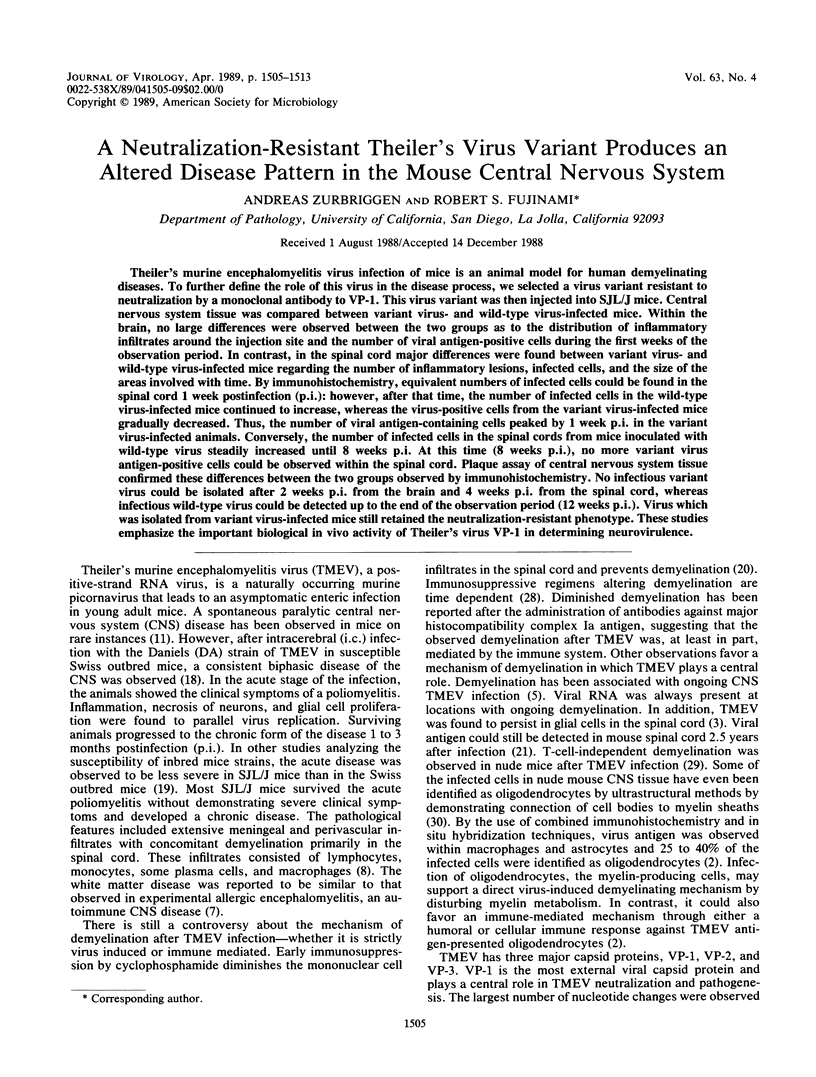
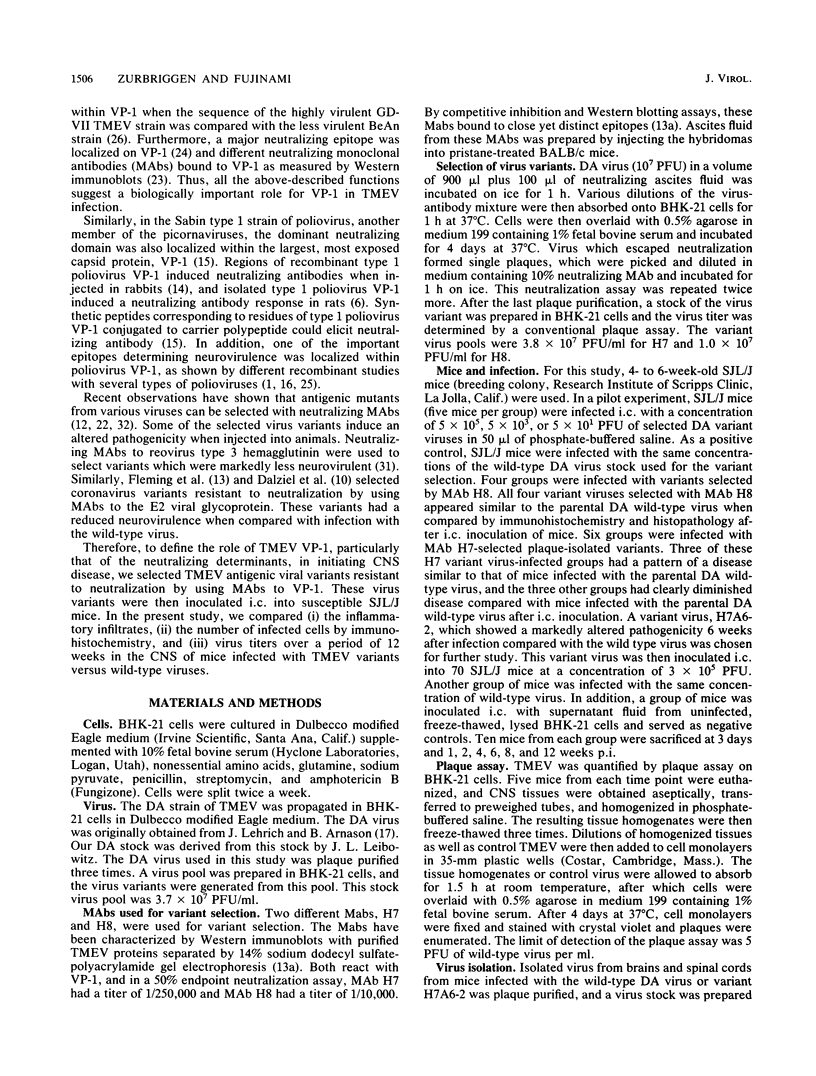
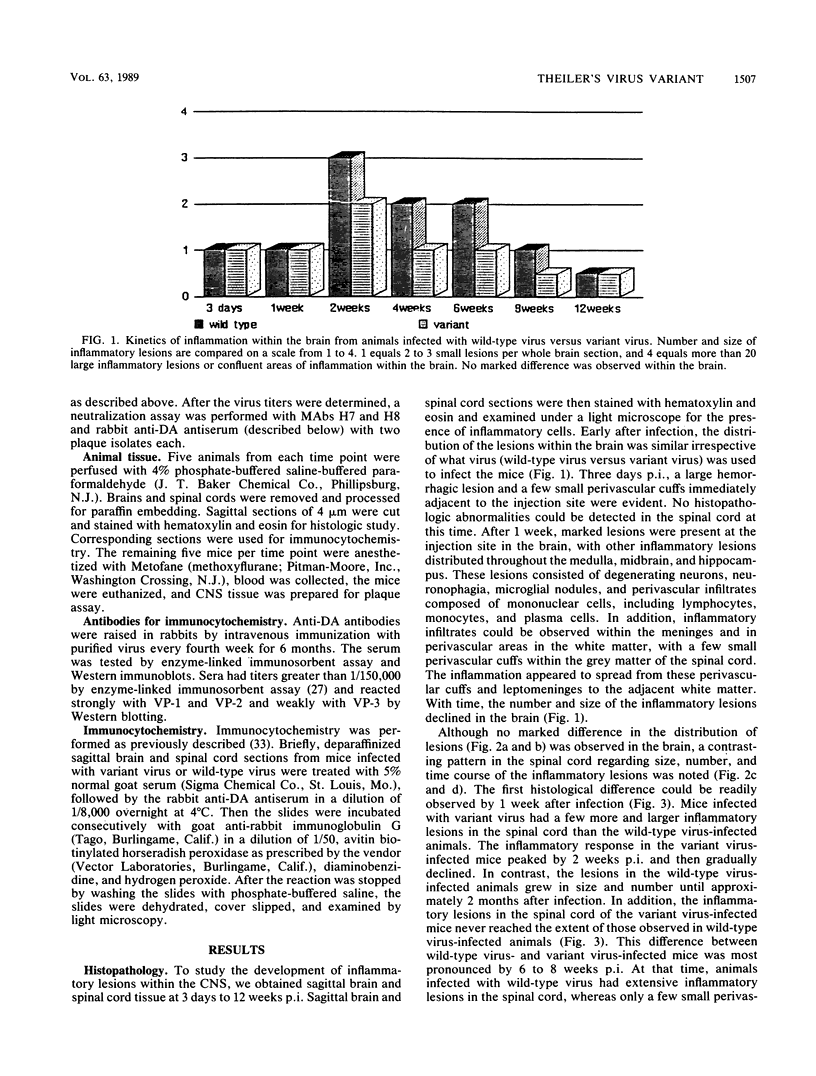
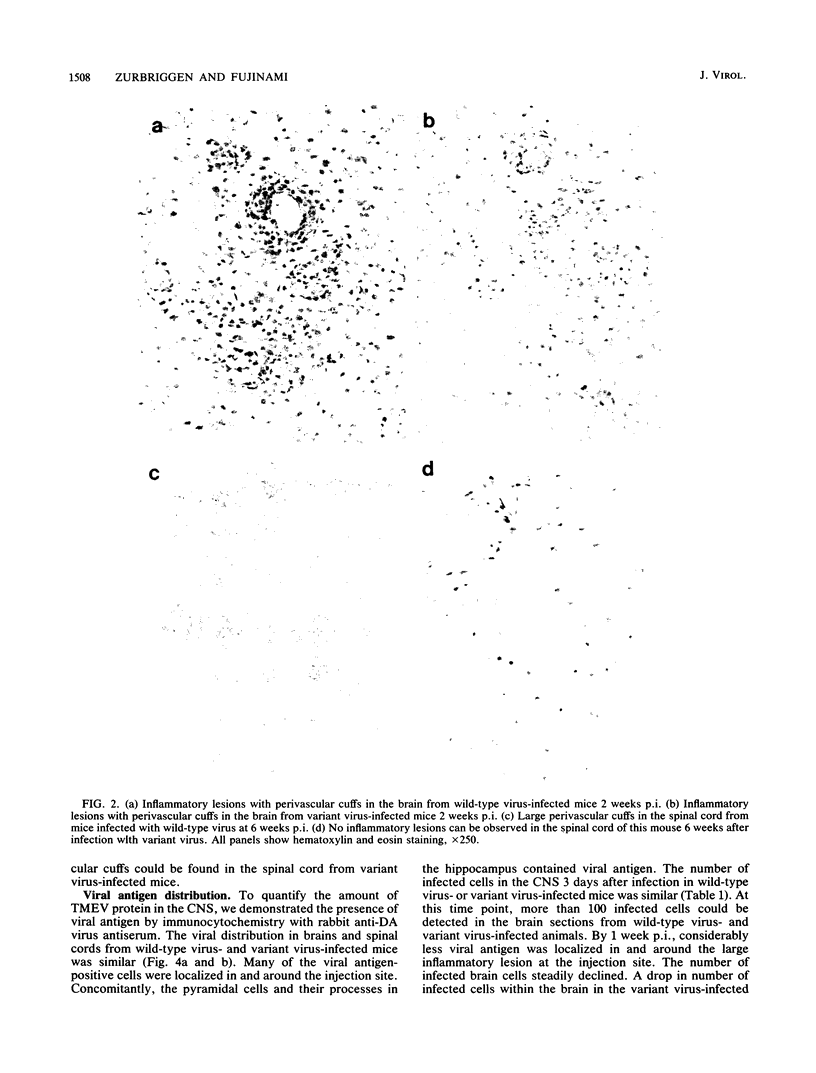
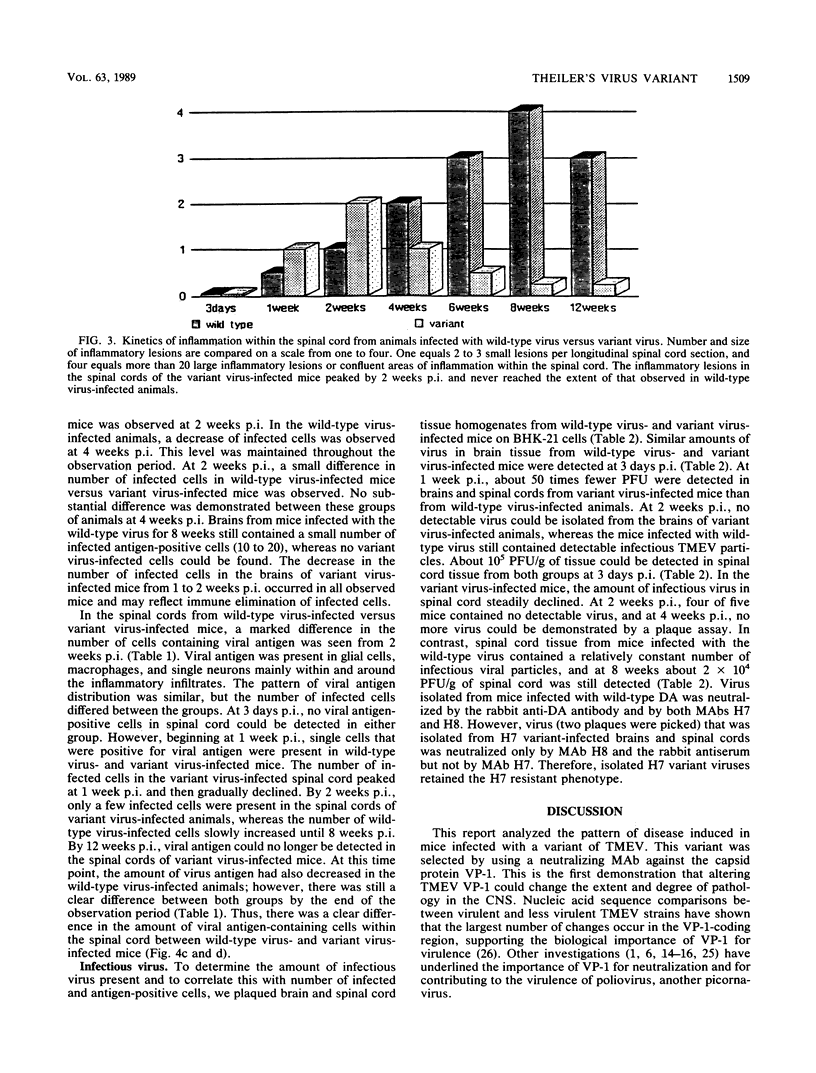
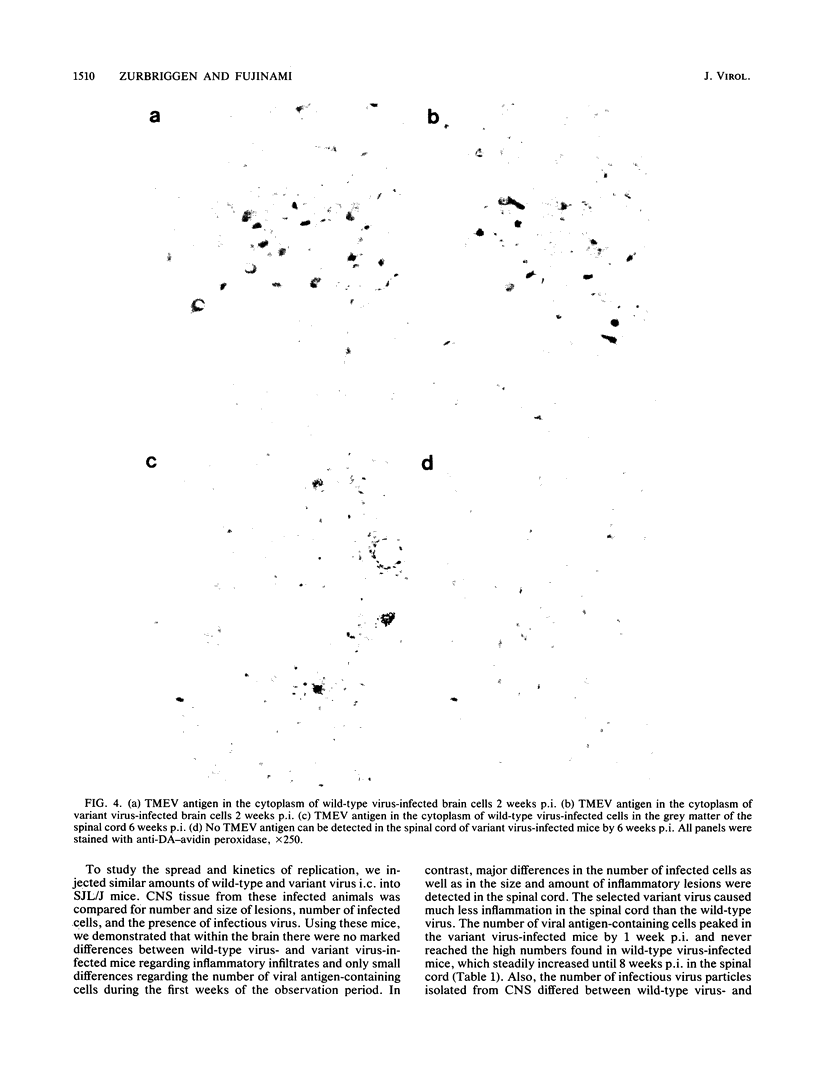
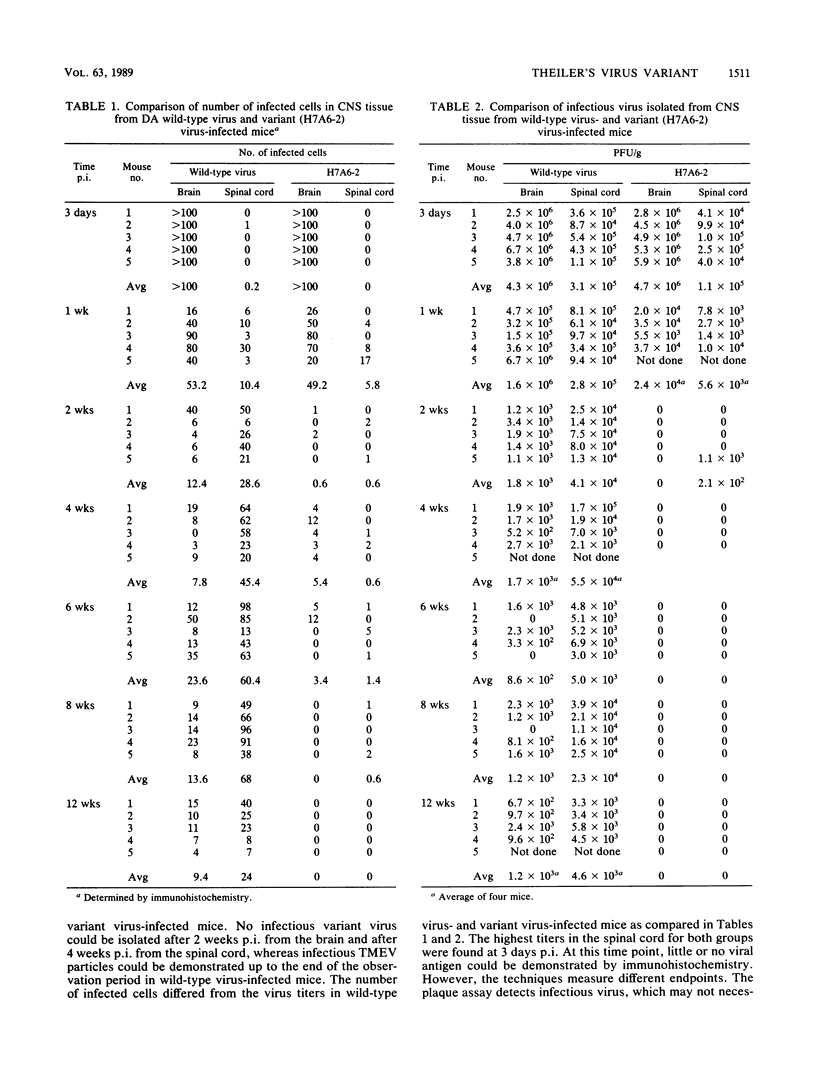
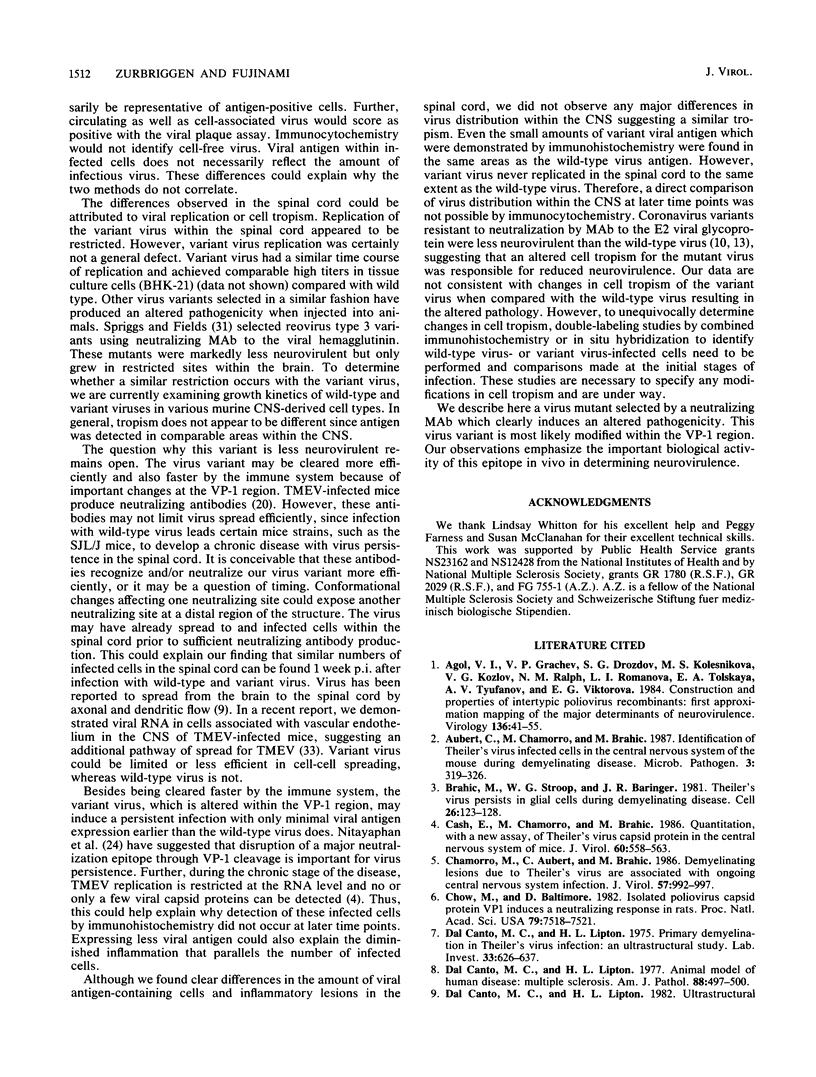
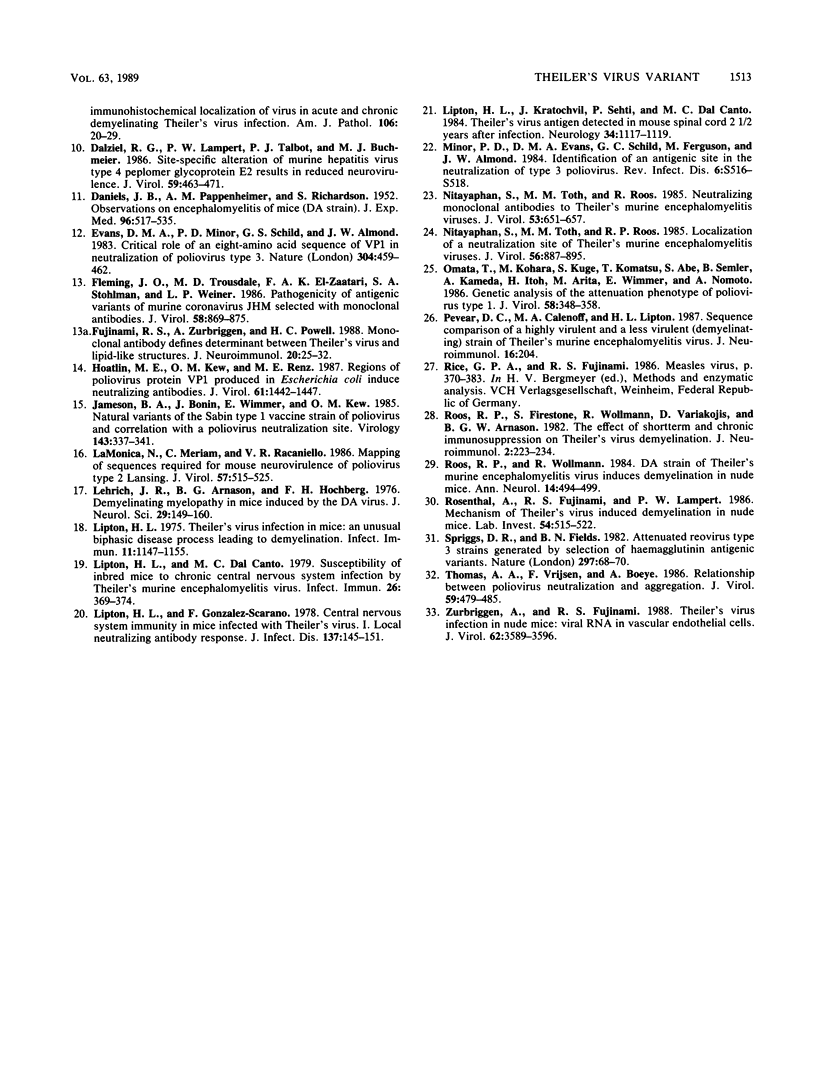
Images in this article
Selected References
These references are in PubMed. This may not be the complete list of references from this article.
- Agol V. I., Grachev V. P., Drozdov S. G., Kolesnikova M. S., Kozlov V. G., Ralph N. M., Romanova L. I., Tolskaya E. A., Tyufanov A. V., Viktorova E. G. Construction and properties of intertypic poliovirus recombinants: first approximation mapping of the major determinants of neurovirulence. Virology. 1984 Jul 15;136(1):41–55. doi: 10.1016/0042-6822(84)90246-0. [DOI] [PubMed] [Google Scholar]
- Aubert C., Chamorro M., Brahic M. Identification of Theiler's virus infected cells in the central nervous system of the mouse during demyelinating disease. Microb Pathog. 1987 Nov;3(5):319–326. doi: 10.1016/0882-4010(87)90002-7. [DOI] [PubMed] [Google Scholar]
- Brahic M., Stroop W. G., Baringer J. R. Theiler's virus persists in glial cells during demyelinating disease. Cell. 1981 Oct;26(1 Pt 1):123–128. doi: 10.1016/0092-8674(81)90040-4. [DOI] [PubMed] [Google Scholar]
- Cash E., Chamorro M., Brahic M. Quantitation, with a new assay, of Theiler's virus capsid protein in the central nervous system of mice. J Virol. 1986 Nov;60(2):558–563. doi: 10.1128/jvi.60.2.558-563.1986. [DOI] [PMC free article] [PubMed] [Google Scholar]
- Chamorro M., Aubert C., Brahic M. Demyelinating lesions due to Theiler's virus are associated with ongoing central nervous system infection. J Virol. 1986 Mar;57(3):992–997. doi: 10.1128/jvi.57.3.992-997.1986. [DOI] [PMC free article] [PubMed] [Google Scholar]
- Chow M., Baltimore D. Isolated poliovirus capsid protein VP1 induces a neutralizing response in rats. Proc Natl Acad Sci U S A. 1982 Dec;79(23):7518–7521. doi: 10.1073/pnas.79.23.7518. [DOI] [PMC free article] [PubMed] [Google Scholar]
- DANIELS J. B., PAPPENHEIMER A. M., RICHARDSON S. Observations on encephalomyelitis of mice (DA strain). J Exp Med. 1952 Dec;96(6):517–530. doi: 10.1084/jem.96.6.517. [DOI] [PMC free article] [PubMed] [Google Scholar]
- Dal Canto M. C., Lipton H. L. Multiple sclerosis. Animal model:Theiler's virus infection in mice. Am J Pathol. 1977 Aug;88(2):497–500. [PMC free article] [PubMed] [Google Scholar]
- Dal Canto M. C., Lipton H. L. Primary demyelination in Theiler's virus infection. An ultrastructural study. Lab Invest. 1975 Dec;33(6):626–637. [PubMed] [Google Scholar]
- Dalziel R. G., Lampert P. W., Talbot P. J., Buchmeier M. J. Site-specific alteration of murine hepatitis virus type 4 peplomer glycoprotein E2 results in reduced neurovirulence. J Virol. 1986 Aug;59(2):463–471. doi: 10.1128/jvi.59.2.463-471.1986. [DOI] [PMC free article] [PubMed] [Google Scholar]
- Evans D. M., Minor P. D., Schild G. S., Almond J. W. Critical role of an eight-amino acid sequence of VP1 in neutralization of poliovirus type 3. Nature. 1983 Aug 4;304(5925):459–462. doi: 10.1038/304459a0. [DOI] [PubMed] [Google Scholar]
- Fleming J. O., Trousdale M. D., el-Zaatari F. A., Stohlman S. A., Weiner L. P. Pathogenicity of antigenic variants of murine coronavirus JHM selected with monoclonal antibodies. J Virol. 1986 Jun;58(3):869–875. doi: 10.1128/jvi.58.3.869-875.1986. [DOI] [PMC free article] [PubMed] [Google Scholar]
- Fujinami R. S., Zurbriggen A., Powell H. C. Monoclonal antibody defines determinant between Theiler's virus and lipid-like structures. J Neuroimmunol. 1988 Nov;20(1):25–32. doi: 10.1016/0165-5728(88)90110-5. [DOI] [PubMed] [Google Scholar]
- Hoatlin M. E., Kew O. M., Renz M. E. Regions of poliovirus protein VP1 produced in Escherichia coli induce neutralizing antibodies. J Virol. 1987 May;61(5):1442–1447. doi: 10.1128/jvi.61.5.1442-1447.1987. [DOI] [PMC free article] [PubMed] [Google Scholar]
- Jameson B. A., Bonin J., Wimmer E., Kew O. M. Natural variants of the Sabin type 1 vaccine strain of poliovirus and correlation with a poliovirus neutralization site. Virology. 1985 May;143(1):337–341. doi: 10.1016/0042-6822(85)90121-7. [DOI] [PubMed] [Google Scholar]
- La Monica N., Meriam C., Racaniello V. R. Mapping of sequences required for mouse neurovirulence of poliovirus type 2 Lansing. J Virol. 1986 Feb;57(2):515–525. doi: 10.1128/jvi.57.2.515-525.1986. [DOI] [PMC free article] [PubMed] [Google Scholar]
- Lehrich J. R., Arnason B. G., Hochberg F. H. Demyelinative myelopathy in mice induced by the DA virus. J Neurol Sci. 1976 Oct;29(2-4):149–160. doi: 10.1016/0022-510x(76)90167-2. [DOI] [PubMed] [Google Scholar]
- Lipton H. L., Dal Canto M. C. Susceptibility of inbred mice to chronic central nervous system infection by Theiler's murine encephalomyelitis virus. Infect Immun. 1979 Oct;26(1):369–374. doi: 10.1128/iai.26.1.369-374.1979. [DOI] [PMC free article] [PubMed] [Google Scholar]
- Lipton H. L., Gonzalez-Scarano F. Central nervous system immunity in mice infected with theiler's virus. I. Local neutralizing antibody response. J Infect Dis. 1978 Feb;137(2):145–151. doi: 10.1093/infdis/137.2.145. [DOI] [PubMed] [Google Scholar]
- Lipton H. L., Kratochvil J., Sethi P., Dal Canto M. C. Theiler's virus antigen detected in mouse spinal cord 2 1/2 years after infection. Neurology. 1984 Aug;34(8):1117–1119. doi: 10.1212/wnl.34.8.1117. [DOI] [PubMed] [Google Scholar]
- Lipton H. L. Theiler's virus infection in mice: an unusual biphasic disease process leading to demyelination. Infect Immun. 1975 May;11(5):1147–1155. doi: 10.1128/iai.11.5.1147-1155.1975. [DOI] [PMC free article] [PubMed] [Google Scholar]
- Minor P. D., Evans D. M., Schild G. C., Ferguson M., Almond J. W. Identification of an antigenic site in the neutralization of type 3 poliovirus. Rev Infect Dis. 1984 May-Jun;6 (Suppl 2):S516–S518. doi: 10.1093/clinids/6.supplement_2.s516. [DOI] [PubMed] [Google Scholar]
- Nitayaphan S., Toth M. M., Roos R. P. Localization of a neutralization site of Theiler's murine encephalomyelitis viruses. J Virol. 1985 Dec;56(3):887–895. doi: 10.1128/jvi.56.3.887-895.1985. [DOI] [PMC free article] [PubMed] [Google Scholar]
- Nitayaphan S., Toth M. M., Roos R. P. Neutralizing monoclonal antibodies to Theiler's murine encephalomyelitis viruses. J Virol. 1985 Feb;53(2):651–657. doi: 10.1128/jvi.53.2.651-657.1985. [DOI] [PMC free article] [PubMed] [Google Scholar]
- Omata T., Kohara M., Kuge S., Komatsu T., Abe S., Semler B. L., Kameda A., Itoh H., Arita M., Wimmer E. Genetic analysis of the attenuation phenotype of poliovirus type 1. J Virol. 1986 May;58(2):348–358. doi: 10.1128/jvi.58.2.348-358.1986. [DOI] [PMC free article] [PubMed] [Google Scholar]
- Roos R. P., Firestone S., Wollmann R., Variakojis D., Arnason B. G. The effect of short-term and chronic immunosuppression on Theiler's virus demyelination. J Neuroimmunol. 1982 Jun;2(3-4):223–234. doi: 10.1016/0165-5728(82)90057-1. [DOI] [PubMed] [Google Scholar]
- Roos R. P., Wollmann R. DA strain of Theiler's murine encephalomyelitis virus induces demyelination in nude mice. Ann Neurol. 1984 May;15(5):494–499. doi: 10.1002/ana.410150516. [DOI] [PubMed] [Google Scholar]
- Rosenthal A., Fujinami R. S., Lampert P. W. Mechanism of Theiler's virus-induced demyelination in nude mice. Lab Invest. 1986 May;54(5):515–522. [PubMed] [Google Scholar]
- Spriggs D. R., Fields B. N. Attenuated reovirus type 3 strains generated by selection of haemagglutinin antigenic variants. Nature. 1982 May 6;297(5861):68–70. doi: 10.1038/297068a0. [DOI] [PubMed] [Google Scholar]
- Thomas A. A., Vrijsen R., Boeyé A. Relationship between poliovirus neutralization and aggregation. J Virol. 1986 Aug;59(2):479–485. doi: 10.1128/jvi.59.2.479-485.1986. [DOI] [PMC free article] [PubMed] [Google Scholar]
- Zurbriggen A., Fujinami R. S. Theiler's virus infection in nude mice: viral RNA in vascular endothelial cells. J Virol. 1988 Oct;62(10):3589–3596. doi: 10.1128/jvi.62.10.3589-3596.1988. [DOI] [PMC free article] [PubMed] [Google Scholar]



